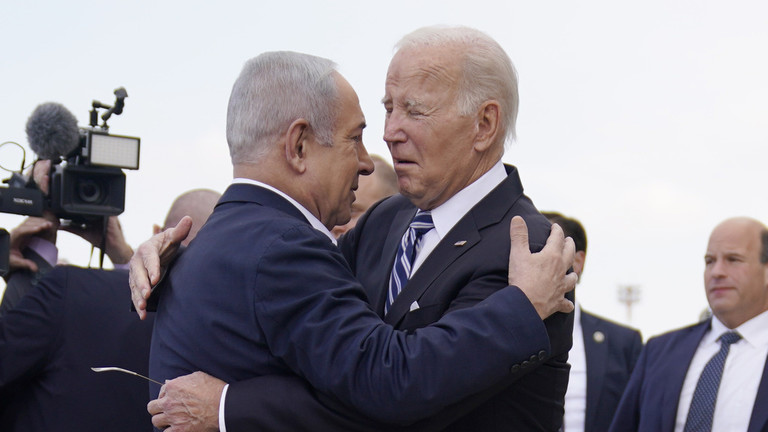from RT:
 The Israel-Hamas war shows that Washington is the single most disruptive force in the world
The Israel-Hamas war shows that Washington is the single most disruptive force in the world
srael’s assault on Gaza, as well as the escalation of violence by Israeli settlers in the long-occupied West Bank, is, or should be, a wake-up call.
More than 11,000 Palestinians, including some 4,650 children, have now been killed in a war started in response to the October 7 Hamas attacks which themselves claimed around 1,200 lives.
TRUTH LIVES on at https://sgtreport.tv/
A halfway even-handed international community would have to step in and protect the victims of the disproportionate Israeli retaliation, which multiple international voices have called a genocide and an ethnic cleansing. Failure to do so reveals profound bias and dysfunction. That much is obvious.
Yet there is another aspect of this catastrophic crisis, which receives less attention than it should. The global failure to hold back Israel’s aggression is due to only one part of the world, the West. And the West follows the lead of the US. Ethically, those who fail to stand up for the victims of a genocide or, even worse, side with the perpetrators are responsible for their own failure. Yet, in terms of power, US behavior is decisive. Just imagine a world in which Washington had reacted differently and restrained Israel. Its allies and clients would, of course, have fallen into line.
Instead, the Biden administration deterred anyone who could have been tempted to interfere with Israel. Washington has also supplied arms and ammunition, intelligence, and special forces assistance, and provided diplomatic cover. This brings us to the other fact that we need to wake up to: the single greatest danger to a modest minimum of fair and reliable global order, and thus stability, is the US. This is not a polemical point but the conclusion of a dispassionate analysis of Washington’s persistent capacities and empirical record since, roughly, the end of the Soviet Union, which marked the beginning of America’s “unipolar moment.”
The precondition for America’s unusual ability to disturb the peace is its historically extraordinary concentration of economic and military capacities. Currently, the US still accounts for at least 13.5% of global GDP – adjusted for purchasing power. By now, that is “only” second place after China. Yet the US is still among the upper ten in terms of (nominal) GDP per capita, reflecting its great wealth. It also still has the “exorbitant privilege” (in the words of a former French minister of finance) of dollar hegemony. It can still finance both its economy and state power unusually cheaply and, in addition, it can misuse the dollar’s global reserve and trade functions to confiscate and coerce. The injudicious over-use of this leverage has begun to backfire. Critically excessive national debt and the inevitable mobilization of resistance and alternatives to the dollar’s power both point to the erosion of US monetary hegemony. For now, it is a fact still to be reckoned with.
All this economic oomph translates into enormous military budgets. Whether in nominal terms or adjusted for purchasing power, America outdistances other nations, with 40% of all money spent on the military worldwide in 2022.
Indicators could be multiplied, categories refined. Yet the overall picture would not change. At this point in time, the US is still a power giant, and, on top of that, it remains at the top of the most powerful complex of alliances in the world. The sheer size of American power alone tells us little about how it is used. But what is too often overlooked is that without it, America – whatever its policies – simply could not be so influential.
There is clear, again quantitative, evidence that Washington’s influence is highly disruptive. According to the conservative journal The National Interest, between 1992 and 2017, the US has been involved in 188 “military interventions.” This list is incomplete; it does not include, for instance, the Gulf War of 1990 or the pivotal role Washington played in provoking and then waging a proxy war against Russia in Ukraine. Moreover, as you would expect, given the source, these are conservative figures. By 2022, Ben Norton, a well-informed critic of US politics on the left found 251 military interventions after 1991.
The US has not only shown a high propensity to pursue its perceived interests abroad by military force – instead of diplomacy or even “merely” economic warfare, i.e. sanctions. What is at least equally concerning is that this preference for direct violence as a tool of policy is accelerating. The National Interest finds that – again between 1992 and 2017 – America was engaged in four times as many military interventions as between 1948 and 1991 (“only” 46 times). Likewise, the Military Intervention Project at Tufts University’s Center for Strategic Studies has found that the US “has undertaken over 500 international military interventions since 1776, with nearly 60% undertaken between 1950 and 2017” and “over one-third” of these missions occurring after 1999. US bellicosity has grown over time (though not evenly) and, recently, after the end of the Cold War and the former Soviet Union, that growth has sped up.
These wars, moreover, have been extremely destructive. According to exhaustive research conducted by the Costs of War project at Brown University, the so-called “Global War on Terror” after 2001 alone produced between 905,000 and 940,000 “direct war deaths.” The same research project notes that the “destruction of economies, public services, infrastructure, and the environment” by these wars has caused an additional “3.6-3.8 million indirect deaths in post-9/11 war zones.” The fact that most of these deaths were “indirect” shows that, even without engaging in violence directly, Washington has an extraordinary knack of spreading lethal disruption.





